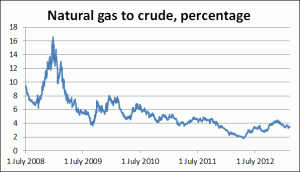George Mitchell, the father of the fracking revolution, is said to have joked that it took him 20 years to become an overnight success. He spent years attempting to marry hydraulic fracturing with horizontal drilling, and finally succeeded in the Barnett Shale in the early 1980′s.
So how could today be the four-year birthday of the shale gas revolution?
Because four years ago today, the long slide in US crude oil prices that began after the early July 2008 peak, driven by the global economic collapse, hit a near-bottom. The NYMEX light sweet crude contract on February 12, 2009 settled at $34.40/b.
It had actually settled less than that right before Christmas, at $33.17, before climbing back over the $40 level and then falling back to the February 12 low.
But February 12 is different than that earlier late-December low. Thatís because the next day, US crude prices as measured by the NYMEX contract began a long climb that put levels above $100 about a year ago, and is threatening that mark again. Meanwhile, natural gas rose fitfully for awhile ó it actually got above $6 a few times in early January ó before its plunge of the past few years, bottoming at a settlement of $1.907/Mcf last April 19.
These two energy commodities, which always had something of a link, essentially had their divorce finalized on February 12, 2009. One year later, on February 12, 2010, the price of crude had risen roughly 98% from its low of one year earlier. The price of natural gas was up only 22%.
As a percentage of the price of US benchmark crude, natural gas on February 12, 2009 was about 13% of the price of crude. A year later, it was 7.5%. As that ratio continued to shrink over time ó it was less than 2% last April, but more recently has been about 3.4% ó it opened up all the possibilities and realities that have been created by the shale gas revolution.
Ethane displaced naphtha in a large swath of petrochemical manufacturing. Companies like Sasol began to look at building Gas-to-Liquids plants in the US and Shell is studying building a petrochemical plant in the Appalachians. The use of natural gas as a fuel gave US refiners an advantage over their international competitors. Fleets sought ways to convert their vehicles to natural gas as a fuel. The list is endless.
And that doesnít even mention the shale revolutionís impact on crude production, which by February 2009 already was showing up in monthly US production numbers. It also is most obvious in the Brent-WTI spread, still in excess of $20 despite the Seaway Pipeline reversal and thousands of rail cars trying to do anything they can to get crude away from Cushing, Oklahoma.
But it was the surge in natural gas production that is having an impact on fuel switching that was previously unimaginable. Even though the work that made the revolution possible began when Ronald Reagan was living in the White House, the sweeping change it is creating has its roots in pricing shifts that began four years ago.
Today also is Abraham Lincolnís birthday. He was known as the Great Emancipator. Thereís serendipity in that.
© 2013 Platts, The McGraw-Hill Companies Inc. All rights reserved. To subscribe or visit go to: http://www.platt
